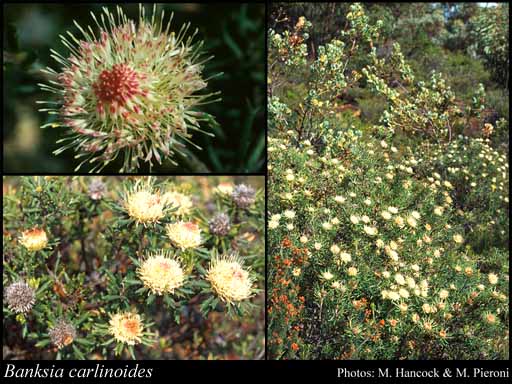- Reference
- Austral.Syst.Bot. 20:66 (2007)
- Conservation Code
- Not threatened
- Naturalised Status
- Native to Western Australia
- Name Status
- Current
Rounded, compact, non-lignotuberous shrub, 0.3-1.2 m high. Fl. white & cream & pink, Aug to Nov. Sand or clay loam, lateritic gravel.

Scientific Description
Shrubs, 0.35-1 m high; branchlets glabrous or hairy. Leaves petiolate, alternate, 20-35 mm long, 3-9 mm wide, hairy; petiole 1-2 mm long; lamina flat, clearly widest above the middle, once divided, tripartitely divided, shallowly divided, teeth distinctly pointing towards the apex, with 3-4 lobes on each side, the margins recurved. Inflorescences tomentose (with matted or tangled, soft, woolly hairs), white, cream or pink; innermost bracts 8-13 mm long, hairy. Perianth 10-20 mm long, hairy, all over, limb apex hirsute (with long, rough and coarse hairs), without awns; pistil 16-23 mm long, curved, style glabrous. Follicles glabrous or hairy, pubescent (with soft, straight, erect hairs), elliptic, 8-11 mm long. Flowers in September or October. Occurs in the South-west (SW) Botanical Province(s), in the Geraldton Sandplains (GS), Swan Coastal Plain (SWA), Avon Wheatbelt (AW) or Jarrah Forest (JF) IBRA subregion(s).
Distribution
- IBRA Regions
- Avon Wheatbelt, Geraldton Sandplains, Jarrah Forest, Swan Coastal Plain.
- IBRA Subregions
- Dandaragan Plateau, Geraldton Hills, Katanning, Lesueur Sandplain, Merredin, Northern Jarrah Forest, Perth.
- Local Government Areas (LGAs)
- Carnamah, Coorow, Dandaragan, Gingin, Greater Geraldton, Irwin, Moora, Three Springs, Victoria Plains.